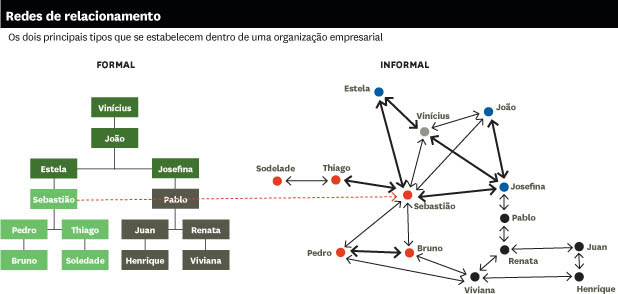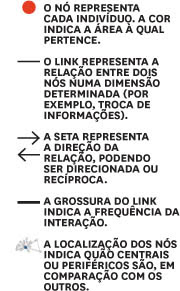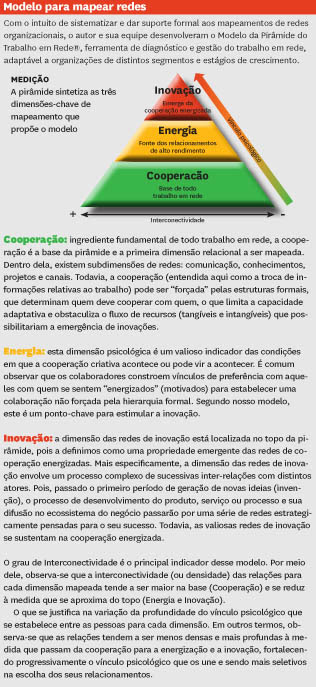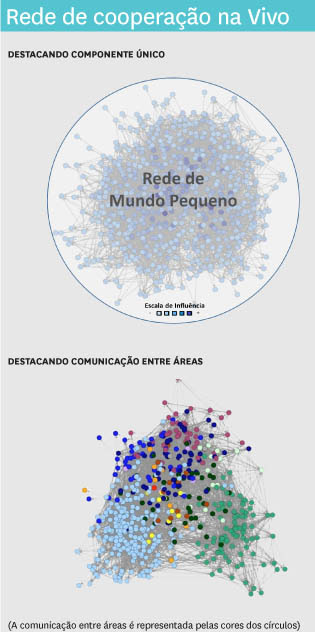In a business ecosystem increasingly complex, hyperconnected and very unstable, the innovation has become the panacea which organizations are urged to adapt. Without entering into the discussion about the correct definition of innovation, in this article we consider that within the "Interconnected Era", innovation no longer depends on individual geniuses and eurekas to be an emergent property of collaborative social networks, in all its development and diffusion process.
Particularly in Brazil, the concept of "social network" is strongly associated with the "social media". However the last one is a particular type of social network that is developed through virtual channels of sharing information, such as Facebook, Twitter and LinkedIn.
Nevertheless from an anthropological point of view, the development of social networks by mankind precedes, at least two million years, the cyberculture phenomenon of social media, because our genre is precisely defined by the ability to establish large social networks between distantly related individuals or even unknown to each other. This formidable cooperative capacity — that social media only empowers — distinguishes us from the cooperative behavior of other social species.
Social networks are, therefore, a sine qua non condition of our species and transcend the channel through which they develop, could be a hunter-gatherer from a Neolithic community or a business organization in the age of interconnectivity.
Finally, we call the social interactions that take place within a business organization, as "organizational networks", that are established both among employees as well as between employees and stakeholders, embracing the entire business ecosystem.
The modern administration - social networks
Today, more than ever, the informal networks determine how work gets done in an organization.
In a context that facilitates interconnectivity through multiple relationship channels, the organizations plastered on their formal and shortsighted organizational charts of their informal networks have increasing difficulties to innovate as innovation emerges from collaborative networks and they are fundamentally informal.


Increasingly discoursed in the repertoire of modern management, in practice, the informal networks remain poorly understood, worst, poorly managed and most of the time perceived as anti destabilizing structures of the status quo. However, informal networks are nowdays more than ever the trully pulse of any organization.
In the above image, on the left, we have the formal organization chart, where relationships are defined by Taylorian labor division. This formal network (as it remains a network) establishes the functional units and the hierarchy of communication interfaces among the individuals who compose it.
On the other hand, the right image present one of the many informal network dimensions that emerge from the interactions in everyday life which determine how the work is actually done. By "dimensions" we refer to the type of relationships that we can mapp, such as: information exchange networks; technical advice, career advice, motivation and energization networks, new ideas networks and so forth.
In the informal networks perspective, the structural position of individuals is dynamic, as it is defined by relationship continuously evolving by the daily interactions (on and offline). In this case, the role that the individual plays is no longer determined by its formal role, but for its strategic location on the network that holds an intrinsic hierarchy. Some of the recurring role of our mappings are:
Local Hub: even without necessarily being a formal leader, has many direct links with other individuals, being able to influence them in their ideas and behaviors.
Bridge Builder: key to innovation. engagment and organizational integration, transcend functional silos creating bridges between different organizational subcultures (for instance, by connecting the engineering with the marketing area, two of the more clear subcultures in avery organization). With access to strategic and not redundant taxit and explicit information, the Bridge Builder can dramatically increase the organization's capacity for innovation, reducing the "time to market".
Bottleneck: generates a high dependence on him (not allways desired) and quickly control the flow of information in his area, making inefficient the all communication and keeping its team at the network edge without any backup in his absence. The decentralization of his non-priority activities is usually a solution to this symptom, common among leadership overloaded of tasks.
Underused Peripheral: unable to integrate itself to the organizational culture, either by a weak socialization or incompatibilities with the dominant culture. To align the organization's values and objectives with hiring processes and further socialization, makes more efficient the integration quality and timing, at the same time reduces the turnover and increases the efficiency of networking.
Intentional Peripheral: for its vocation or lifestyle choice owns more relationships outside than within the organization. They are usually researchers, vendors or representatives, whose focus is outside the porous boundaries of the company. Learn to respect the focus of its relations with the external environment, without ceasing to encourage the connections with key people of the internal environment, is what this profile type needs for a better network performance.
To reveal the strategic relevance of informal networks does not mean to make obsolete the formal organizational charts, as these reach a significant regulatory function. On the contrary, we believe that the key is in its dynamic alignment and synergy that the formal and informal structures should generate for the development of the organization as a living organism.
Traumatic restructuring times should consider the relationship that is dialectically established between the formal and informal networks, as this strongly impacts the organizational evolution.
Particularly in mergers & acquisitions processes, are left over evidences of the experiences percentage that do not meet the expected synergies, evidencing as the main cause the cultural shock and struggle at the time of integrating the informal networks involved in the equation.
Uncover the flows and patterns of informal networks, in synergy with the formal organization chart, enables to see ways to make the most integrated organizations, innovative and adaptable to the challenges of "network society".

Two faces of the same culture
Late in 2010, Tree Intelligence conducted a pioneering research project on the mapping of informal networks in Vivo Telecommunications, company leader in the Brazilian mobile telecommunications market and now controlled by Telefonica.
The goal was to uncover the social capital of the company through their informal networks, and thus stimulate their adaptive capacity and innovation, striking attributes of its organizational culture.
For that, we mapped the informal networks of Cooperation, Energy and Innovation, defined by the Organizational Pyramid Network Model® , involving approximately 620 managers, which means all middle and upper management of the company.
Also were mapped hundreds of knowledge networks and strategic projects along with the main communication channels (online and offline) through which the various networks are established.
To conduct this innovative research, we relied on Vivo's CEO Roberto Lima and the HR Director Sandra Lima at that time. They were fundamental sponsors of this project. Also we had a close collaboration of Vivo strategic branding consultancy, Thymus Branding lead by Fabio Seo.

Having in hands Vivo’s mapping, emerged a clear pattern of network behavior, that we have segmented into three levels of analysis defined by the model:
1) Macrorredes: No nível das macrorredes, as três dimensões mapeadas apresentam um padrão similar de relações e seguem a disposição proposta no modelo da pirâmide, mostrando uma maior interconectividade na Cooperação e menor na Energia e Inovação.
In the illustration above is observed specifically Cooperation network of Vivo’s managers, which shows the characteristic of a "Small World Network", where all employees (identified as circles) interconnect with each other directly or indirectly in an average of three steps away (each step equivalent to one person).
In this way an analysis of the macro-level network Cooperation established that the presence of a large and cohesive component interrelations, portrays Vivo as a company that in fact works in network in that specific moment.
2) Mezzo-Level Network: Already in the grouping or community level, the image bellow shows the same network Cooperation, this time treated with an algorithm which enhances the separation between the circles, enabling the identification of affinity clusters within the single component.
In this way in the upper part of the network is observed a more heterogeneous region when it comes to communication between different areas, defined by the circles colors.
In the bottom of the network, we observe two major areas (represented by the sky-blue color and light green) that are still in touch with the rest of the network, showing a greater homogeneity of connections inside.
Particularly the lower right area, whose circles are marked with bright green color, shows a more pronounced separation of the rest of the network. This separation was interpreted as representing more than one functional silo, a different subculture from the rest of the network.
3) Micro-Level Networks: Finally, at the individual level, or micro networks, specific Informal Talents and Local Influencers were identified within each area and Bridge Builders between the areas. The centrality of most of these employees was repeated in three mapped dimensions determining what in Network Science is call as the "multiplexity effect". The appreciation and engagement of these individuals with multiple skills to influence and build bridges are fundamental to stimulate the integration between functional silos, which through them that subcultures can be strategically integrated.
With this mapping example is possible to glimpse the power of Organizational Network Analysis in general, and model of the Organizational Pyramid Network Model® in particular for the diagnosis and management of strategic networks in the age of interconnectivity.
Published by Harvard Business Review (January 12, 2012)




